Kabul: NATO took over eastern Afghanistan from US forces, assuming control of 12,000 American troops and extending its command to the entire country. NATO commander British General David Richards was promoted to a four-star general today.
****
Helmand Province: British officials are bracing themselves for the prospect that they may have to fight the Taliban during the winter. Traditionally in the Afghan War, fighting wanes in the wintertime due to heavy snows and picks up again in the spring, but in Helmand Province, where British forces are concentrated, there is little or no snow, so the Taliban may fight on all through winter.
A fragile truce with local tribal leaders remained in effect in the red-hot Musa Qala District, which is overrun by the Taliban and has seen persistent fighting since the British showed up.
The Taliban have accused the British of violating the truce by keeping troops in a village where they were supposed to have been removed under truce terms. The truce is actually more between tribal leaders and the Taliban and involves the British to a lesser extent.
*****
Wednesday, October 4
*****
Nahri Sarraj District, Helmand Province, Night: The Taliban attacked a police checkpoint here and the subsequent battle killed 6 Taliban and wounded 3 others. 3 police were also wounded.
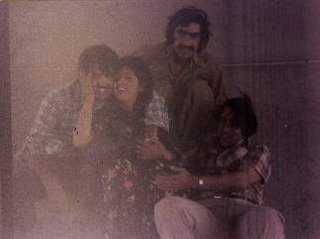
A fascinating photo from 1978 from Sam Sloan's web page (see the Nuristani entry below) showing an Afghan prostitute entertaining some Afghan men under a bridge in Gereshk, the main town in the Nahri Sarraj District. The woman was later seen soliciting men in downtown Kandahar! The men in this photo said they were not going to have sex with this woman, as that would be against their Muslim religion; instead, they were just messing around with her. Sure guys!
Note the 1970's hairdos on the guys and the Indian features of all present, including the woman. Now the place is overrun with Taliban fundamentalist cretins and all fun is being outlawed. I think this place was more fun under the heathen Commies, no?
*****Note the 1970's hairdos on the guys and the Indian features of all present, including the woman. Now the place is overrun with Taliban fundamentalist cretins and all fun is being outlawed. I think this place was more fun under the heathen Commies, no?
*****
Sado Kala, Dih Yak District, Ghazni Province: US A-10 Thunderbolt II's attacked the Taliban during a battle between US troops and guerrillas. The Dih Yak District is 89% Hazara and 11% Pashtun, but this area right next to the Taliban-overrun Andar District may be mostly Pashtun.
The Taliban hate the Hazara and had openly genocidal aims against them when the Taliban were in power, possibly because the Hazara are Shia. Sado Kala (map here) is 11 1/2 miles northeast of Miri, the capital of the Andar District.
*****
Uruzgan Khas, Uruzgan Province: A US B-1 Lancer attacked Taliban fighters during a battle between them and US forces here.
*****
Samangam, Samangam Province: Royal Air Force Harrier GR-7's and US Air Force A-10s provided attacked guerrillas were fighting ISAF forces here. It is unclear who these guerrillas are in Samangam (map here).
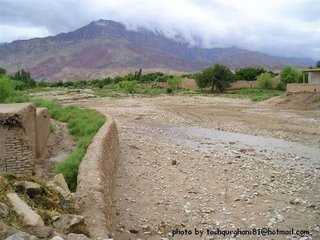 Tashkurgan, Samangan Province. This beautiful little village is apparently located on the far northern border of this province. As you can see, this area is quite a bit wetter than most of Afghanistan.
Tashkurgan, Samangan Province. This beautiful little village is apparently located on the far northern border of this province. As you can see, this area is quite a bit wetter than most of Afghanistan.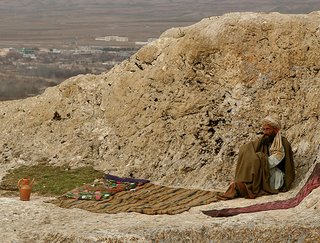 This photo, taken in Samangan Province, lacked a description, so I will have to make one up myself. An Afghan man sits next to a blanket with a few items on it and a pot of water to the side. A village is in the background.
This photo, taken in Samangan Province, lacked a description, so I will have to make one up myself. An Afghan man sits next to a blanket with a few items on it and a pot of water to the side. A village is in the background.*****
Garmser, Helmand Province: British RAF GR-7s attacked guerrillas who were fighting British troops here.
Now Zad, Helmand Province: US Air Force A-10s attacked Taliban forces who were fighting British troops near here.
Kandahar Province: The Taliban attacked Canadian troops here for the third straight day. Taliban forces fired several RPG's at a Canadian base and detonated a roadside bomb on a Canadian armored vehicle. The roadside bomb wounded Canadian troops.
*****
Kabul: The very heavy fighting this year is causing a large number of refugees in southern Afghanistan. The office of the U.N. High Commissioner for Refugees said an estimated 15,000 families have been displaced in Kandahar, Helmand and Uruzgan provinces since July. The UNHCR is already taking care of 116,400 refugees fleeing fighting and drought and this adds to its burden.
Families who fled the recent fighting in the Panjwayi District of Kandahar Province reportedly went back to their homes during the day but returned to Kandahar at night as they felt that conditions were still too unstable for them to stay the night.
*****
Kabul: After NATO takes command over the US troops in eastern Afghanistan, the forces under its control will grow to 33,000. US troops will continue to head up the search for Osama bin Laden in Eastern Afghanistan. 12,000 US troops will go under NATO command and another 8,000 will remain under US command.
Tuesday, October 3
****
Siah Choy and Sperwan, Panjwayi District, Kandahar Province, AM: The Taliban attacked Afghan soldiers who were pushing west on foot from Siah Choy. Canadian soldiers were supporting the push with an LAV stationed by the Arghanbab River. Taliban forces formed a 1/2 mile firing line and Canadian and Afghan forces were forced to retreat.
The Panjwayi District has experienced an upsurge in Taliban activity after it was reportedly "cleared" of Taliban in Operation Medusa ended on September 14. Siah Choy (map here) is located along the Arghandab River, 23 miles west of Panjwayi, the district capital. Sperwan (map here) is 11 miles southwest of Siah Choy and 19 miles southeast of Panjwayi.
Sperwan was the scene of major battles last month after the Taliban took control of a school on a hill and used it as a base to train fighters.
*****
Kandahar, 2:20 PM: Suicide motorcycle bomb attack on a Canadian convoy in Kandahar killed the bomber but did not cause any Canadian casualties. A Canadian vehicle went up in flames but somehow no one was hurt. Go figure.
*****
Panjwayi District, Kandahar Province, 4:50 PM: The Taliban attacked NATO troops simultaneously from 3 separate positions with small arms, RPG's and mortars as troops worked to clear an area of mines and roadside bombs in preparation for a road project.
2 Canadian soldiers, Sergeant Craig Paul Gillam and Corporal Robert Thomas James Mitchell, both members of a reconnaissance squad, were killed in the attack, and 8 other NATO troops were wounded, including 5 Canadians and 3 US troops.
*****
*****
Korengal, Pech District, Kunar Province, Evening: Fighting between US troops and guerrillas in this very dangerous area killed 2 US troops, Medic Spc. Angelo Vaccaro and Spc. Fernando Daniel Robinson, and wounded 3 more. An Afghan soldier was also killed.
US forces fired small arms and artillery at the guerrillas. Vaccaro was killed while by an RPG while going to the aid of wounded soldiers. Robinson was killed when guerrillas fired small arms and RPG's and Coalition forces.
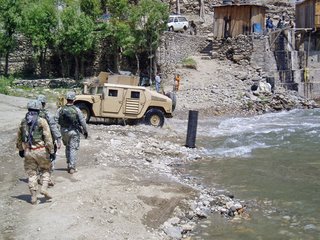 US troops building a bridge over the Pech River in the Pech District. Note the wooden homes built on sloping terrain.
US troops building a bridge over the Pech River in the Pech District. Note the wooden homes built on sloping terrain.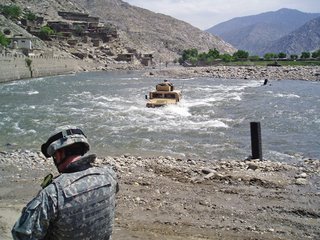 A US vehicle attempts to cross the raging Pech River in the Pech District. Note the homes that are virtually carved out of the sides of mountains. This area is very wild and right now it is swarming with Al Qaeda, Taliban, Hezb-i-Islami, Lashkar-e Toiba and a variety of other fundamentalist kooks. Bin Laden and Zawahiri may be hiding here, but I think they are somewhat to the north of the Pech River. Travel around here is for the most part by foot or mule.
A US vehicle attempts to cross the raging Pech River in the Pech District. Note the homes that are virtually carved out of the sides of mountains. This area is very wild and right now it is swarming with Al Qaeda, Taliban, Hezb-i-Islami, Lashkar-e Toiba and a variety of other fundamentalist kooks. Bin Laden and Zawahiri may be hiding here, but I think they are somewhat to the north of the Pech River. Travel around here is for the most part by foot or mule.****
Gomal District, Paktika Province, Late: The Taliban attacked a border police post here. In the ensuing 1-hour battle, 3 Afghan police and 10 Taliban were killed. 3 police were also wounded. The border of this district borders on South Waziristan in Pakistan.
Kohl District, Balochistan Province, Pakistan: Baloch guerrillas fighting for autonomy fired rockets at paramilitary troops riding in their vehicle to fetch water from a well, killing 3 and wounding 2 more. Kohl in 248 miles west of Quetta.
Kohe Regak: A US Air Force B-1 Lancer conducted strikes on Taliban positions here. This location could not be found on any map.
Shinkay Ghar: A US Air Force B-1 attacked Taliban forces who were fighting US troops near here. There are several mountains and one mountain range with this name, mostly in Paktika and Zabul Provinces, so it is not clear what area is being referred to, though I suspect it is a mountain in Paktika.
****
Moladis, Waygal District, Nuristan Province: US Navy F/A-18Cs attacked guerrillas who were fighting US forces near here. It is very possible that Osama bin Laden is presently in Nuristan. Moladis (map here) is located 5 miles southwest of Waygal, the district capital, on a tributary of the Pech River.
The people here are members of the Kalash ethnic group, hence they are neither Tajiks, Uzbeks, Hazara or Pashtuns. They speak Kalasha. The language is also called Waigali. It is only spoken by about 1,500 people. The Nuristani languages are in their own separate branch of the Indo-Aryan family, the same family as Hindi and Sanskrit.
There is only 10 miles of road in this wild and mountainous district and most of the travel is by foot or by donkey. Women play an active role in the economy here, working in the fields and tending herd animals. All field work is done by women; men's work is restricted to the herd animals. Many of the herd animals die due to lack of veterinary services.
There is little arable land here but the locals have created some terraced fields on the steep hills. The region is heavily forested. Of the 19 schools here, only 4 actually have buildings and the rest are held outdoors.
The origins of the Kalash of Afghanistan are somewhat mysterious, but it is thought that their ancestors were Hindu refugees fleeing encroachment of Muslim Afghans on their lands. Their original religion, before conversion to Islam, seems to be a millenarian response to the Islamic assault on them. They worshiped the Hindu god Indra.
There is much controversy about the origins of the Nuristanis. The legend is that when Alexander the Great conquered the region, he found the Nuristanis there. Some of his men stayed behind and married into the group. The legend of a light-skinned tribe related to Alexander the Great was set.
Little more was written about them for centuries. Rudyard Kipling based his "The Man Who Would Be King" on the Nuristanis. The very notion of the existence of the Nuristanis was considered to be a myth until a British explorer, George Robinson went there in 1892 and wrote a tract called, "Kafirs of the Hindu Kush", a seminal work on the group which can still be found in most large libraries.
That year, the Durand Line carved out Afghanistan from India and Nuristan ended up on the Afghan side. The Afghan king, Abdul Rehman Khan, learning that the Nuristanis were not Muslims, immediately attacked them and forcibly converted them to Islam. The region, formerly called Kafirstan (Land of the Infidels), was renamed to Nuristan (Land of Light).
The Afghan war started in Nuristan as the Nuristanis were the first to rebel against the new Communist government. Check out this fascinating webpage by Sam Sloan.
Sloan is a very entertaining figure - a San Francisco trust fund kid who is apparently a high-functioning paranoid schizophrenic who travels the world and gets involved in all sorts of wild adventures (I spent a month or 2 wading through his incredible, endless webpage back in 1997).
Sloan crossed into Nuristan only once. A group of Nuristanis carried his vehicle across a river (the river was about as deep as the car) as there was no bridge - a typical situation is this extremely wild area. Sloan was in Nuristan a week after the Communist regime seized power and witnessed the new Communist governor coming to Nuristan to explain the nature of the new Communist regime.
The Nuristanis crowded around acted like they wanted to kill the governor. He left the next day and the Nuristanis soon rose up against the regime.
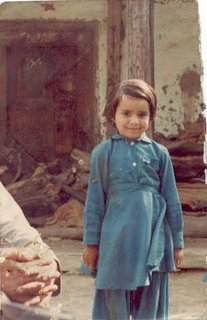 A young Nuristani girl, Obtainably Nuristani, in her village at age 5. She later emigrated to Canada, becoming one of the first Nuristanis to do so. She later graduated with honors in school. Early British explorers to the region noted that Nuristani girls were so beautiful when they were young, but when they grew older, one could hardly ever see one, due to the custom of purdah.
A young Nuristani girl, Obtainably Nuristani, in her village at age 5. She later emigrated to Canada, becoming one of the first Nuristanis to do so. She later graduated with honors in school. Early British explorers to the region noted that Nuristani girls were so beautiful when they were young, but when they grew older, one could hardly ever see one, due to the custom of purdah.****
Garmser, Helmand Province: British Royal Air Force Harrier GR-7s attacked Taliban forces fighting British troops here.
Sangin, Helmand Province: British Royal Air Force Harrier GR-7s attacked Taliban forces fighting British troops here.
Band-e Kajaki, Helmand Province: British Royal Air Force Harrier GR-7s attacked Taliban forces fighting British troops here.
Kandahar: British Royal Air Force Harrier GR-7s and US Navy F/A-18Cs attacked Taliban forces fighting US and Canadian troops here.
Monday, October 2
*****
Gilan, Gilan District, Ghazni Province: US Air Force A-10 Thunderbolt II's, a B-1B Lancer and French M-2000 Mirages attacked Taliban forces fighting US troops near Gilan. Gilan is the capital of the Gilan District in southern Ghazni on the border with eastern Zabul Province. The district is 100% Pashtun and has started to see some fighting recently. The district is mostly desert and seriously drought-effected land.
This district has actually been a Taliban stronghold since the fall of the Taliban regime, which has kept most aid agencies out. The water table is falling and many of the wells have run dry. Families walk an average of 2-3 miles to get water. Only 50% of the arable land is being cultivated due to the drought and the rest is seriously effected by lack of water. All farming here is by irrigation.
In one area, there has been no harvest at all recently. 95% of the herd animals have died in the drought. The health sector is in very bad shape. The buildings are devastated and there are only a few medical professionals. There are no female medical professionals. As a consequence, women typically never go to the doctor and childbirth frequently kills both the mother and the child.
The literacy rate here is an appalling 3% for men and 0% for women. The education sector is very poor. 50% of the schools have no buildings so they are held outdoors. There are actually 2 girls' schools here, but one is so informal that girls can only attend first grade. After that, school is over. Students often have to walk long distances to school.
Girls over the age of 10-12 go into purdah and are not permitted to leave their own villages except in the company of a male relative. Women spend all their time inside the home and do not even work in the fields. Women are not allowed to present any claims at all to the shuras for adjudication, hence women have no legal representation.
Recently, a shura allowed a woman to present her case to them, but they basically refused to deal with it. Women continued to be married against their will. Girls are all married by age 16. Due to the ultra-conservatism of this area, aid agencies feel that any programs to empower women will be met with male hostility.
*****
Bar Kanday, Kunar Province: Air Force A-10s attacked guerrillas fighting US troops near here. Bar Kanday (map here) is in the Pech District, 13 miles west of Asadabad along the Pech River in extremely rugged terrain.
Now Zad, Helmand Province: British Royal Air Force GR-7 Harriers and U.S. Navy F/A-18 Hornets attacked Taliban forces fighting British and Afghan troops near here. The battle killed 3 Taliban and wounded 2 more.
Kuchnay Darvishan, Garmser District, Helmand Province: Navy F/A-18s attacked Taliban forces fighting British troops near here. Kuchnay Darvishan (map here) is 10 miles south of Garmser, the capital of the district.
Kabul: A suicide bomber blew himself up next to a NATO convoy, wounding 3 soldiers and 3 civilians and damaging a US vehicle. The bomber was standing next to a gas station when he ran towards a US 4-wheel drive vehicle entering Kabul and detonated himself.
Kabul: Another suicide bomber blew himself up in Mekroyan Square here, wounding 3 people and killing himself. The target of the attack was not known.
Musa Qala District, Helmand Province: British troops reached an agreement with Afghan elders aimed at ending Taliban attacks here. 6 British soldiers have been killed here since August. The British have agreed to not launch any more offensives and the elders will try to convince the Taliban not to stage any more attacks. There are around 140 British troops stationed here.
*****
Nahri Sarraj District, Helmand Province: Taliban fighters on a motorcycle attacked Afghan police here, killing 2 policemen and wounding 2 more.
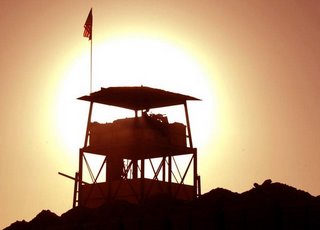 A great photo of a sunrise at a US firebase in Gereshk, the main town in the Nahri Sarraj District. This base has now been taken over the British
A great photo of a sunrise at a US firebase in Gereshk, the main town in the Nahri Sarraj District. This base has now been taken over the British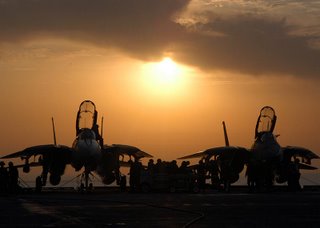 Another superb sunrise photo of a US base in Gereshk. The US has handed over this whole area to the British, and now they are being attacked just about every day in this region.
Another superb sunrise photo of a US base in Gereshk. The US has handed over this whole area to the British, and now they are being attacked just about every day in this region.*****
*****
Paktia Province: Roadside bomb attack on Afghan troops here killed 4 Afghan soldiers.
Sunday, October 1
Wana, South Waziristan, Pakistan, Early AM: Guerrillas fired 3 rockets into a Pakistani military base here, but the rockets landed in a field inside the base and no one was hurt. Troops fired back with small arms.
Nangarhar province, Late: Guerrillas threw a hand grenade into a mosque where worshipers were praying, wounding 7 civilians. The motive for the attack was not known.
Samangan District, Samangam Province, Late: A group of 6 Finnish soldiers was practicing maneuvers here when 2 or 3 unknown persons opened fire on their vehicle twice in a 15-minute period, wounding 1 Finnish soldier. Finnish soldiers returned fire. Later investigations revealed that the shots were fired in error by Afghan police themselves.
Paktika Province: A 2-hour long battle here left 2 Taliban killed and 4 more wounded.
*****
Bajour Tribal Area, Pakistan: A gun battle between feuding tribesmen killed 6 people and left 2 more critically wounded administrator for the region said yesterday. Bajour is totally infested with terrorists, guerrillas and Islamist fanatics. I believe that bin Laden may presently be hiding in this area or across the border in Kunar or Nuristan Provinces of Afghanistan.
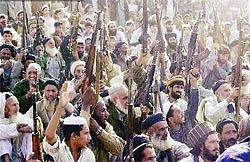
Bajour tribesmen ready to go fight for the Taliban after the US invasion in 2001. Many poorly equipped fighters flooded over the border to fight US troops under the influence of a radical mullah and a large number of them were killed. This area is totally terrorist-infested right now and bin Laden and Zawahiri may in fact be hiding here. This area is about ready to sign another Waziristan-style truce with the Pakistani government that will basically hand the area over to the radicals.
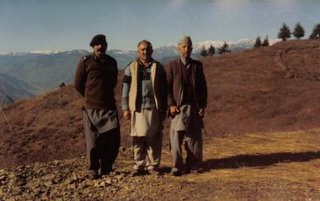 An interesting photo taken along the Afghan/Pakistan border in the Bajour Tribal Area during the Soviet War. 2 of the men in the photo are Dr. Mohammad Gulroz Khan, a noted author and poet from the region and a Pakistani military officer, Khakhay Bajour.
An interesting photo taken along the Afghan/Pakistan border in the Bajour Tribal Area during the Soviet War. 2 of the men in the photo are Dr. Mohammad Gulroz Khan, a noted author and poet from the region and a Pakistani military officer, Khakhay Bajour.
 An interesting photo taken along the Afghan/Pakistan border in the Bajour Tribal Area during the Soviet War. 2 of the men in the photo are Dr. Mohammad Gulroz Khan, a noted author and poet from the region and a Pakistani military officer, Khakhay Bajour.
An interesting photo taken along the Afghan/Pakistan border in the Bajour Tribal Area during the Soviet War. 2 of the men in the photo are Dr. Mohammad Gulroz Khan, a noted author and poet from the region and a Pakistani military officer, Khakhay Bajour.*****
Musa Qala District, Helmand Province: An Afghan civilian vehicle hit a land mine that the Taliban had laid for British troops here, killing 5 civilians. Further fighting in the province left 5 combatants dead, possibly Taliban. There were no details on this fighting.
Chaman, Pakistan: Guerrillas attacked an oil tanker carrying oil for US forces in Afghanistan as it was heading into Afghanistan, setting the tanker on fire and wounding the driver. Tankers in this region are loaded with oil at the port in Karachi and then the oil goes by tanker north through Pakistan and across the border to US forces. Chaman is Taliban Central.
*****
Gurziwan District, Faryab Province: US and Afghan troops arrested Qadir Sarhozi, a former mujahedin commander who fought against the Soviets. It was not known why he was arrested. Sarhozi also fought against the Taliban for the Northern Alliance. He was the 3rd former mujahedin commander arrested in recent days. Faryab Province is very quiet.
The Gurziwan District is not in Faryab Province; it is in Sar-e-Pol Province next door. Uzbeks and Tajiks are the main ethnic groups here. Warlords, often former mujahedin, are reportedly involved in land seizures, extortion and other charming activities. They even have their own jails where they imprison and torture people they do not like.
Rashid Dostum, one of the worst figures to come out of the Afghan War, is very powerful here and frequently fights his rivals for various insipid reasons. The Karzai government is dominated by such wonderful warlords. It is probably for humanitarian activities such as this that Sarhozi was arrested.
****
Quetta, Pakistan: Pakistani police raided the private Al-Khidmat Hospital in Quetta and arrested six Afghan Taliban fighters The wounded Taliban had arrived at the hospital two days prior with bullet wounds. The 6 Taliban, along and 3 other Taliban who were their attendants, were transferred to a police hospital.
Miran Shah, North Waziristan, Pakistan: Pro-Taliban officials shut down an office here that they set up to fight crime. They were apparently worried that the Pakistani government would see it as an affront to their authority. The office was set up so that locals could report robberies, car thefts and murders.
Kajaki 'Ulya, Kajaki District, Helmand Province: US Air Force A-10s attacked Taliban fighters battling British troops near Kajaki `Ulya. Kajaki 'Ulya is right next to the Kajaki Dam.
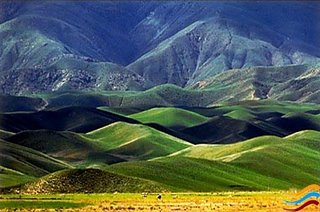


No comments:
Post a Comment